Oct 2007
FSA Guidance Note on Anisakis worm infestation of wild salmon
September 2007 Reference: FSH/0015
A raft of hygiene legislation sets out extensive legal requirements for food businesses that place fishery products on the market for human consumption. However, these requirements do not have force over the preparation and handling of food for ‘private or domestic’ use, or where small quantities of primary products are supplied to final consumers and local retail establishments. The catching of wild salmon from UK rivers for personal or local consumption falls into these categories.
Consequently the FSA are advising consumers of about hygiene practices to ensure that these products are safe to eat. Parasites in fish, particularly anisakis, can, if ingested alive, cause serious health problems. Therefore the FSA recommends that anyone consuming wild salmon taken from UK rivers adheres to the following advice:
- Visually inspect the wild salmon to detect and remove parasites. Those fish which remain obviously contaminated should not be consumed
-
If wild salmon is to be eaten raw or almost raw it should be frozen in all parts for at least 24 hours, at a temperature of –20ºC or colder. This will ensure that any non-visible parasites or undetectable larvae of nematodes are destroyed.
-
This freezing advice also extends to wild salmon that are to undergo a cold smoking process or to be eaten after marinating or salting i.e. as in Gravadlax.
-
Where wild salmon is to be hot smoked (internal temperature above 60ºC), which is sufficient to kill any parasites present, then it is safe to eat without freezing first.
Where it is not possible to carry out adequate freezing it is advisable to cook the wild salmon. A temperature of 70ºC for two minutes will kill any parasitic contamination present. As there is no infallible method of detecting and removing larvae, this advice is particularly relevant for pregnant women and elderly people, where ingestion of live parasites from fish could pose a serious health risk.
This guidance has been issued by the Fish and Shellfish Hygiene Branch, which is part of the FSA’s Primary Production Division. To discuss or seek further clarification please contact Mr Michael Talbot on 0207 276 8991 or by email to michael.talbot@foodstandards.gsi.gov.uk
News – Sept 2007
2006 salmon and Sea Trout Catches
The official salmon and sea trout catch returns for 2006 have recently been published by FRS. The total rod catch for salmon was the fifth highest since records began in 1952, with an increasing proportion being released. Nationwide sea trout catches continue to decline with the 2006 reported catch being the second lowest on record. Local anglers will be very aware of the plight of sea trout in Ayrshire although catches do seem to be better this year.
Of the Ayrshire rivers the Stinchar had the highest official catch in 2006 with a total of 779 salmon and grilse recorded. The River Girvan (release rate 56%) was only local river where the release rate for salmon was above the Scottish average of 55%.
The full report can be downloaded at the following web link: www.marlab.ac.uk/Delivery/News/
Fisherman’s Supper
The Trust’s Annual Fisherman’s Supper will take place on Friday 9th November in the Cariston Hotel, Ayr. This popular event goes from strength to strength. Speaker this year are Charles Jardine, a renowned angling journalist, and Denis Johnson, a well known local after-dinner raconteur. Brian Shaw, the Trust’s senior biologist will provide a summary of the Trust’s work in 2007. There will also be a raffle with many excellent prizes.
Please come along for an excellent evening’s entertainment and to help support the work of the Trust. Tickets are available from Janette Galbraith, Ayrshire Rivers Trust, Donald Hendrie Building, Auchincruive, Ayr, KA6 5HW at £20 per ticket or £190 per table of ten.
Tyne “sea trout” found to be a hybrid
Genetic analysis of scales taken from the large tagged sea trout caught on the River Doon in late July (see Aug news below) has revealed that the fish was in fact a trout/salmon hybrid. Whilst the fish looked sea trout like, the overall appearance of the fish, and the fact that it had strayed so far from its river of origin, prompted further analysis.
The analysis was carried out by staff at the Freshwater Fisheries Laboratory in Pitlochry. An extract of the report is included below –
“Scales, which had been removed from a 10.5lb sea trout found to contain a salmon fish tag, were used as a source of crude total cell DNA (nuclear mitochondrial DNA) It is possible to discriminate between trout, salmon and trout/ salmon hybrids by amplification of the 5sRNA gene. Where a fish has been identified as a hybrid the maternal species can also be determined by amplification of the mitochondrial Cytochrome b gene followed by digestion of the amplified product with the restriction endonuclease Alu I”.
The analysis found that the Doon fish was the result of a cross between a female trout and a male salmon. First generation hybrids between salmon and trout are not unusual in the wild, in fact, parr showing physical characteristics intermediate between salmon and trout are found on several occasions each year by the Trust biologists. Second generation hybrids are rarely found as most hybrids are sterile. We can only speculate as to how the hybridisation occurred but salmonid spawning sites can often be a bit of a free for all. At serious risk to their lives mature male salmon or trout parr often sneak in to grab a few eggs for a meal or to shed their milt as the female lays her eggs. Studies have shown that a surprisingly high proportion of salmon eggs are fertilised by mature salmon parr.
This finding in no way diminishes John Veitch’s achievement in landed such a fine specimen, in fact it may well turn out to be a record for an authenticated trout/salmon hybrid!
Aug 2007
Swollen vent in Stinchar grilse
Local anglers will no doubt be interested in the following pictures from a grilse caught on the Stinchar recently. It had a swollen and bleeding vent, typical of that reported in grilse from across Scotland this year.

The pictures were taken by Sue Veitch who is a vet. Whilst gutting the fish, which had been caught by her husband, her professional training took over leading her to investigate potential causes of the inflammation. Dissection revealed numerous coiled roundworms in the region of the vent.


The roundworms were approximately 1.5cm in length. Reports from FRS have implicated the worm Anisakis simplex in the swollen vents problem although confirmation as a primary, or secondary, cause of the problem has not yet been given.
Welltrees Bridge, A70
Motorists travelling along the A70 between Lugar and Muirkirk will no doubt be highly pleased with the straight new road, and the removal of an accident blackspot, at the site of the new Welltrees Bridge over the Gass Water. However, in order to appreciate the attractive design of the asymmetric pre-cast concrete arch bridge you have to get off the highway. The bridge features some relatively new construction techniques, such as the use of steel tendons, embedded in the infill, to hold the segmented wing walls in place.
The Trust’s main concern with bridges is to ensure that the interests of fish passage, and other river inhabitants, are considered and at all stages of the construction process. The Trust would like to commend East Ayrshire Council Roads Department for the excellent work done in that regard at Welltrees. Natural substate in a range of sizes has been incorporated below the bridge to provide slow flows and a variety of depths which should allow fish passage at a range of water heights.
Jim Howie, East Ayrshire Council Roads Department, commented that they had worked closely with SEPA at every stage of the construction and that they were very pleased with the finished product. Even though the Gass Water is inaccessible to migratory fish such as salmon, due to the presence of a large waterfall at the confluence with the Glenmuir Water, it is important that fish such as resident brown trout, which make local migrations e.g. for spawning, are able to move freely within their range.
Tyne sea trout caught in the River Doon
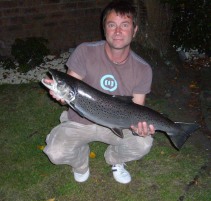 On the 28th July, John Veitch caught a 10.2lb male sea trout in Holms beat of the River Doon. Beat manager Carlos Van Heddegem reckoned it was the biggest sea trout caught on the Doon in his lifetime. John, who has fished the Doon since he was seven, says that it was the most powerful fish that he has ever caught on the river and that it was similar in that respect to some of the salmon he has landed from Norwegian rivers. Unfortunately the fish was deeply hooked and could not be revived.
On the 28th July, John Veitch caught a 10.2lb male sea trout in Holms beat of the River Doon. Beat manager Carlos Van Heddegem reckoned it was the biggest sea trout caught on the Doon in his lifetime. John, who has fished the Doon since he was seven, says that it was the most powerful fish that he has ever caught on the river and that it was similar in that respect to some of the salmon he has landed from Norwegian rivers. Unfortunately the fish was deeply hooked and could not be revived.
The story took a twist when an internal tag was discovered on the dinner plate of one of the diners enjoying a fillet of the fish. After an investigation the Trust were able to establish that the fish had been tagged on the 4th May, 2005 in the River Tyne (Newcastle) as a 15.2cm smolt. The tag had been surgically implanted into an incision in the stomach of the fish before it was stitched up. The tag was an acoustic transmitter deployed during experimental work to monitor the movement of smolts in the Tyne Estuary.
Scale readings showed that the fish had spent 2 or 3 years in freshwater followed by 2 years at sea, with no spawning marks present. The fish had shown the high growth rate typical of sea trout from that part of the country. Our west coast sea trout tend to be slower growing and a fish of that size would most likely have spawned several times and be many years older.
The Trust advise that whenever possible all sea trout caught in Ayrshire’s rivers should be carefully returned, in order to protect the remaining breeding population. There are more positive signs for sea trout this season with increased catches reported on the Doon and other Ayrshire Rivers.
Fair at Skeldon resounding success
The Country Fair on 10th June was a great success, helped by sunny weather and an interesting range of stalls and attractions. Many thanks to Stan Brodie for providing the Trust with such an excellent venue. This year was the first time the Fair had been held at Skeldon Estate on the banks of the River Doon. Attendance was very good and thanks to everyone who attended. Money raised by the Fair will help the Trust continue its work throughout Ayrshire over the coming year. We hope to see you all again next year – watch this space as the date and venue is still to be decided. Below: Falconer Alan Rothery in action, Skeldon 2007

Sea lamprey sightings
Sea lampreys were seen in the River Stinchar and River Doon in June. Sea lampreys enter the rivers to spawn in May or June, having grown at sea as parasites of other large fish. Anglers occasionally report salmon with a circular mark left by a lamprey. Migratory lampreys suffer habitat loss as a result of dams and weirs which prevent upstream access to spawning grounds. Pollution may also be a problem, but most of Ayrshire’s rivers are clean enough to support lampreys. Two other species of lamprey, the river lamprey and non-migratory brook lamprey, are common in Ayrshire’s rivers. Below: Sea lamprey found dead after spawning
Live pearl mussels discovered
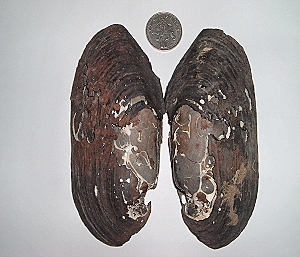 Freshwater pearl mussel shell from the River Doon |
Live pearl mussels were found in the lower River Doon in June. A person carrying out river works licensed by SEPA discovered the mussels, which were confirmed as freshwater pearl mussels by Trust biologist Brian Shaw.
The Trust plans to complete a survey of the River Doon for freshwater pearl mussels this summer. A grant for the survey has been approved by Scottish Natural Heritage and the River Doon Salmon Fishery Board. The River Doon was once famous for its population of freshwater pearl mussels, which were heavily exploited by fishermen. It is now illegal to fish for freshwater pearl mussels without a government licence and it is illegal to buy or sell the pearls which are occasionally found inside them. The Doon population is thought to be in decline and unlike some other rivers in Scotland, the River Doon has not been classed as a Special Area of Conservation (SAC) for pearl mussels. SAC status has only been awarded to rivers with pearl mussels which are actively reproducing in large numbers.
Nevertheless, the Trust is very interested to see if there are any pearl mussels left on the River Doon. The population has probably been damaged by over-fishing and pollution. If there are any left, it may be possible to assist the population using hatchery techniques, as the pearl mussel depends on salmonid fish in order to colonise new areas of river. The mussel has a very interesting lifecycle, travelling as a harmless parasite on the gills of fish during its larval stage. At the moment the Trust is planning to carry out a survey of the lower River Doon (downstream of Loch Doon dam) and investigate reports of pearl mussels on the lower River Girvan. A progress report will be posted on this site in the autumn, once the survey has taken place. The Trust is interested in hearing from anyone who has seen any pearl mussel shells recently. Pearl mussel shells are very strong in comparison with the shells of common swan and duck mussels, which are much thinner and break easily. Please do not disturb any living mussels or collect dead shells, as both these activities are illegal without a licence.
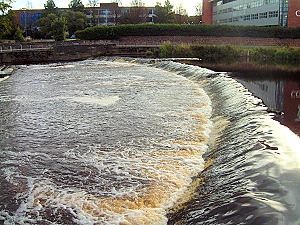 Upper of two weirs at Nethermills, by Ayr College |
Fish pass installation on River Ayr
Installation of fish passes and general improvements to the structure of the weirs at Nethermills on the lower River Ayr are due to begin on 14th May. The Trust has been closely involved in the plans for the improvements in fish access over the weirs which can be seen in the river next to Ayr College. Migratory fish such as salmon, trout, eels and lampreys should benefit.
Garden opening, Doonholm 27th May
The gardens at Doonholm Estate opened to visitors on Sunday 27th May as part of the Scottish Gardens Scheme. The gardens on the banks of the River Doon include several features of historic interest, including ancient trees planted by the Burns family of Alloway. Proceeds from the garden opening were donated to Ayrshire Rivers Trust.
March 2007 – Membership costs
Following a review of Trust activities, the Trustees decided to increase the cost of membership from 1 March 2007. The cost has remained constant since 2002 and is low in comparison with other similar organisations. The Trustees feel that the membership subscription continues to offer very good value and would urge members to continue supporting the Trust. Comments from members regarding any aspect of Trust activities are always welcome, particularly in this case with regard to the value that membership provides. Members automatically receive copies of newsletters and Annual Reports. Members are also invited to Trust events such as the Fishermans Supper and river monitoring workshops. A programme of events for members will be published later in the year. Please continue to support the Trust by joining, or if you prefer to make a donation please contact us.
New costs for members joining from 1st March 2007:
Junior – £5.00 (unchanged)
Adult – £15.00
Corporate – £60.00
Life – £220.00
N.B. Existing members paying by standing order, whose order is due on or after 1st May 2007, will be sent a new form to instruct their bank of the new amount.
February 2007 – Hybrid found in genetic sample
A salmon/trout hybrid has been found in one of the Scottish samples collected for the Atlantic Salmon Arc Project (ASAP). ASAP has been set up to investigate the genetics of wild salmon populations across western Europe. Ayrshire Rivers Trust is responsible for organising the collection of samples from the west coast of Scotland. The salmon/trout hybrid was recently identified in a collection of samples from the River Annan near Dumfries. Analysis of the samples is being carried out by Andrew Griffiths at Exeter University and scientists at Oviedo University in Spain.
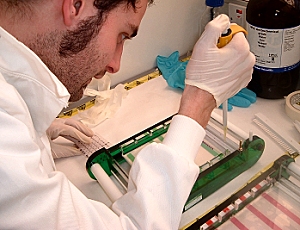 Ayrshire Rivers Trust biologist Peter Minting recently visited Exeter to learn about how the analysis is completed. It was then that the hybrid was discovered, among around 40 European samples suspected to contain DNA common to salmon and trout. Six other hybrid fish were identified during the analysis, all of which were from Spain. Salmon/trout hybrids are unusual but do occur in rivers where salmon and trout spawn. It is not certain if such hybrids are capable of reproducing. The 40 suspected hybrids were from a total of around 4,000 samples collected from several countries including Scotland, England, Wales, France and Spain. Biologists were asked to collect salmon parr samples (fin clips) for the project, so it is interesting that some hybrids have been included. This may suggest that some parr which look like salmon are in fact salmon/trout hybrids. Given the similarity between salmon and trout parr, it would be fairly easy to accidentally include a hybrid. No trout have been found in the samples so far, suggesting that (contrary to what some anglers may suggest?) biologists can tell the difference between a salmon and a trout!
Ayrshire Rivers Trust biologist Peter Minting recently visited Exeter to learn about how the analysis is completed. It was then that the hybrid was discovered, among around 40 European samples suspected to contain DNA common to salmon and trout. Six other hybrid fish were identified during the analysis, all of which were from Spain. Salmon/trout hybrids are unusual but do occur in rivers where salmon and trout spawn. It is not certain if such hybrids are capable of reproducing. The 40 suspected hybrids were from a total of around 4,000 samples collected from several countries including Scotland, England, Wales, France and Spain. Biologists were asked to collect salmon parr samples (fin clips) for the project, so it is interesting that some hybrids have been included. This may suggest that some parr which look like salmon are in fact salmon/trout hybrids. Given the similarity between salmon and trout parr, it would be fairly easy to accidentally include a hybrid. No trout have been found in the samples so far, suggesting that (contrary to what some anglers may suggest?) biologists can tell the difference between a salmon and a trout!
Background to the Atlantic Salmon Arc Project (ASAP)
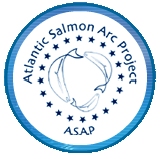 Salmon/trout hybrid testing is really just a small part of the ASAP project. The project has been designed to build a genetic profile of salmon populations across western Europe, which could be used in a number of ways. For instance, a salmon caught in the mid-Atlantic could be linked back to its home river. Scientists may find that salmon from a particular river forage in a particular part of the ocean, or they may feed as a mixed stock. The genetic similarity of salmon between different rivers will also be established. It is not yet known whether salmon from adjacent rivers are different enough to regard them as distinct populations but it is quite possible. Preliminary results produced for England and Wales show a degree of genetic clustering, with salmon from adjacent rivers more similar than those from rivers far away. Such information is important from a management perspective. Marine fishing policies could be adapted to protect specific stocks, if salmon forage as distinct sub-populations. Activities such as stocking salmon in rivers should be more closely controlled if it is shown that salmon from individual rivers have distinct genetic identities. This is important in terms of fish survival and protection of our natural heritage. Inappropriate stocking could result in a loss of biodiversity.
Salmon/trout hybrid testing is really just a small part of the ASAP project. The project has been designed to build a genetic profile of salmon populations across western Europe, which could be used in a number of ways. For instance, a salmon caught in the mid-Atlantic could be linked back to its home river. Scientists may find that salmon from a particular river forage in a particular part of the ocean, or they may feed as a mixed stock. The genetic similarity of salmon between different rivers will also be established. It is not yet known whether salmon from adjacent rivers are different enough to regard them as distinct populations but it is quite possible. Preliminary results produced for England and Wales show a degree of genetic clustering, with salmon from adjacent rivers more similar than those from rivers far away. Such information is important from a management perspective. Marine fishing policies could be adapted to protect specific stocks, if salmon forage as distinct sub-populations. Activities such as stocking salmon in rivers should be more closely controlled if it is shown that salmon from individual rivers have distinct genetic identities. This is important in terms of fish survival and protection of our natural heritage. Inappropriate stocking could result in a loss of biodiversity.
The final results of the genetic analysis should be completed by March 2007. A project meeting will be held in Asturias, Spain on 14-16 March to discuss the findings and the next stage of the project. ASAP director Dylan Bright, based at Westcountry Rivers Trust in Cornwall, is now developing plans for phase two in conjunction with partners from other member states. The project is funded by the European Union under a scheme designed to help communities along the Atlantic coast. The second stage of the project will include activities designed to benefit salmon populations and communities which benefit from salmon as a resource. This will include salmon habitat restoration in key areas.
January 2007 – Wet, warm winter
2006 had the wettest November on record on the River Doon, according to rain gauge data collected by Doonholm Estate. The Estate has been keeping records for over 150 years. Autumn 2006 (September to November) was also the warmest autumn ever in Britain, according to the Met Office records for the last 347 years. River levels have remained high throughout the winter in Ayrshire with flooding in some areas. Possible negative impacts for salmon and trout include redd washout and obstructions to migration caused by fallen trees. At the same time, high river levels may have a positive effect, with migratory fish able to reach spawning areas which are rarely accessible. It will be interesting to see the effects of the wet winter on fish population survey results in 2007.
The unusual weather may well be linked to climate change. Most climate change experts predict that winters in Scotland will become warmer and wetter as the globe heats up. Others claim that Scotland will enter a local ice-age, if global changes in the climate result in the ‘switching off’ of the Gulf Stream. This oceanic current keeps north-western Europe much warmer than other areas of the planet at the same latitude. Changes to oceanic currents could already be having an impact on salmon populations at sea. Ayrshire salmon feed and complete their main growth phase in the North Atlantic.
The Met Office predicts that 2007 will be the warmest year on record globally, beating the current record set in 1998. A new record for the warmest year globally has been set several times in the last decade, strong evidence that global warming is a reality. More evidence of the link between human activities and global warming can be seen in the Al Gore film ‘An Inconvenient Truth’.

